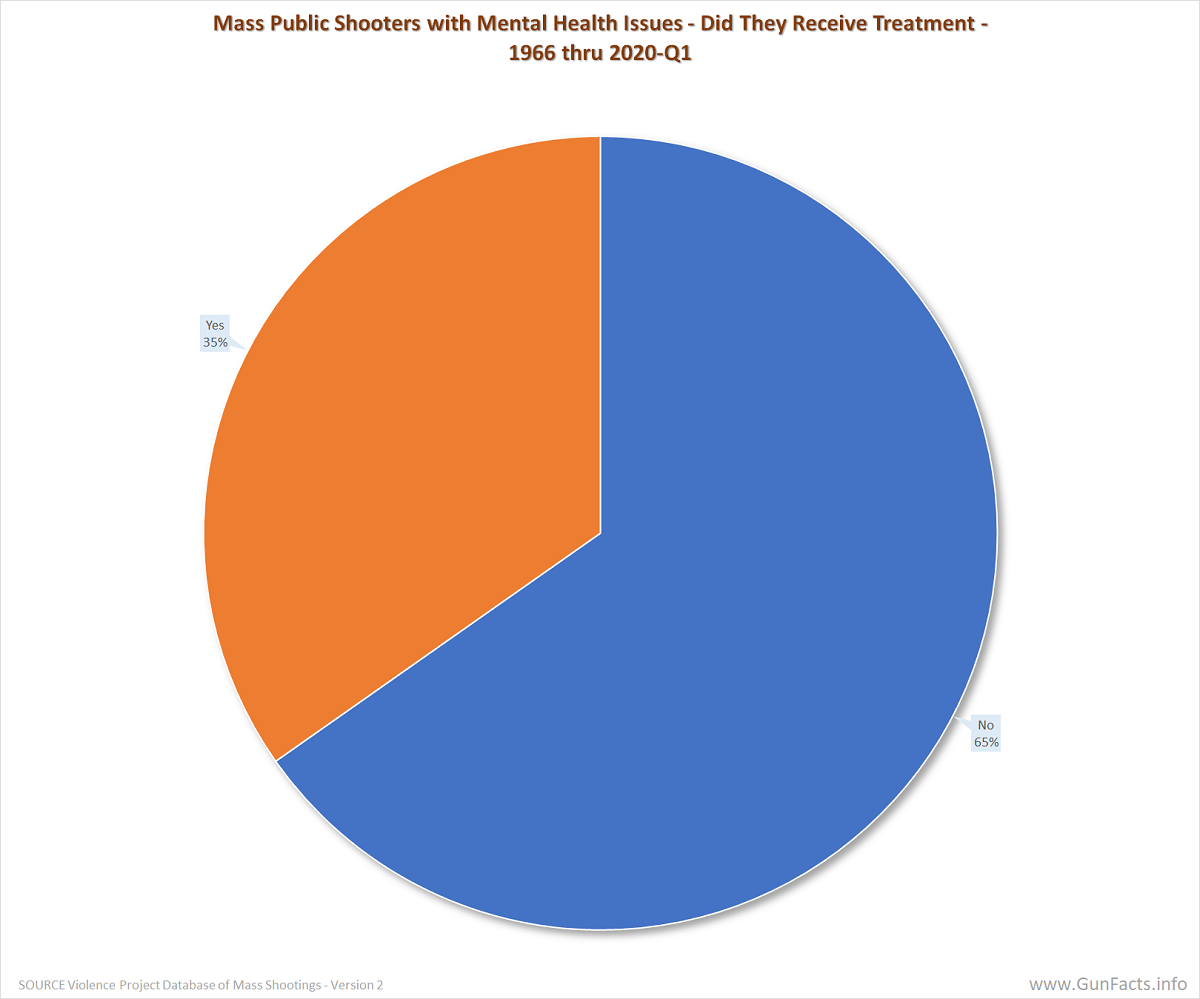Mental Breakdown
“You gotta be crazy to shoot a bunch of strangers dead!”
Yes. Crazy and untreated. A deeper dig into the mass public shooting (MPS) database with the most detailed mental health insights reveals that the American mental health system is ailing.
High Level Takeaways
- 68% of MPS perpetrators have mental illness.
- Of those, 65% of them never received treatment.
- Of perpetrators who were previously suicidal, only half received treatment.
- Mood disorder medications have an outsized influence.
The Violence Project Database
A product of government funding and greater access to medical records, the Violence Project database of MPS has the most complete accounting of the mental health status of MPS perpetrators. Their database starts in 1966 with the legendary University of Texas tower shooting and goes on through early 2020.
They also have nearly complete records of the perp’s mental health history, including rarified data such as the perp’s suicidality, their intention to die during the attack, prior mental health hospitalization, prior counseling, voluntary or mandatory counseling, if they were prescribed psychiatric medications, and if they are on the Autism spectrum (which we have noted before is a leading indicator for both MPSs and serial killers).
The basic question herein is how big of a hole exists in the American mental health system as it relates to MPSs. Go steal a Mac truck and you can drive through it.
Untreated and Mentally Ill Shooters
Mass public shooters are typically mentally ill and are unlikely to have received treatment.
 |
|||||||||||||||||||||||
 |
|||||||||||||||||||||||
 |
|||||||||||||||||||||||
 |
|||||||||||||||||||||||
|
|||||||||||||||||||||||
The Violence Project database agrees with the other major MPS databases on the mental health scorecard. Their more accurate tally is that a full 68% of MPS perpetrators were diagnosed with or showed signs of mental illness, and about half of those were suicidal to boot.
This big divide between mentally ill mass public shooters and treatment
Our first alarming insight: though 68% of MPS perpetrators are mentally unsound, only 31% of MPS perps ever received treatment.
Digging a little deeper, we looked at just the records of MPS perps who were listed as mentally ill. A whopping 65% of them never received treatment.
This is the core of the debate for MPSs. If a large majority (68%) of MPS perps are mentally fragile but only 35% of them get help, then the American mental health system is letting the lion’s share of MPS perps slip through the cracks.
There is medication to their madness – the role of psychotropics in mass shootings
Interestingly, and somewhat predictably, a full 34% of MPS perpetrators who had any sign of mental illness had been prescribed psychotropic medications. As we discovered in some original Gun Facts research, there is a positive (albeit bivariate) correlation between adverse reactions to psychotropic medications and MPS.
Let’s do a quick recap:
- 68% of shooters had mental illness. Of those:
- 31% received treatment.
- 34% had been prescribed psychotropic medications.
Those last two points are not an anomaly. Your family doctor can (but shouldn’t) prescribe psychotropics. But it does happen. Hence, there are a few entries in the database where someone (a) had signs of mental illness, but (b) never received counseling for their mental illness, and yet (c) someone prescribed mind-altering drugs to them.
[ED: I had a girlfriend who had amazingly bad PMS. Her family doctor prescribed her Prozac. Thankfully, she was a smart lass, and after taking exactly one pill said “No, this is stupid” and flushed the rest.]
Degrees of derangement
We thought it may be helpful to understand what varieties of mental illness are associated with MPS perpetrators, but the data is not all that helpful.
First, the classification scheme used by the Violence Project is narrow. In our study of psychotropic medications and mass murders, we identified 25 different but specific types of FDA-defined mental maladies. The Violence Project identified mood and thought disorders, as well as the two grab-bag classifications of “other” and “signs but no diagnosis.”
This leads to us seeing a nearly even mix of mood, thought and “signs” disorders (16–21% range). Hence, no greatly discernable pattern.
Now, here is where it gets a little scary. When we look at just the perpetrators who (a) had mental health issues and (b) were prescribed psychotropic medications, we see that drugs treating mood disorders are disproportionately associated with MPSs. Mood disorder medications have some well-known names and side-effects. In the SSRI (selective serotonin reuptake inhibitor) class we find Zoloft, Prozac, Paxil, Luvox (the Columbine shooter’s meds), Lexapro and Celexa. In the MAOI (monoamine oxidase inhibitors) we see Parnate and Nardil. The list under tricyclics is too long to transcribe.
Bringing Mental Health Home
The point is, we see a descending but statistically observable chain with MPS perpetrators:
- 68% have some form of mental illness.
- 32–73% (depending on how you account) are suicidal.
- Only 35% get treatment.
- Of those treated, 34% were on medications.
- And for mood disorders, 48–80% were on medications.
Psychiatric hospitals were often not nice places. But since the 1970s, we disposed of 64% of all psych beds, and instead put at-risk people on the streets with pockets full of pills—which they may be too unreliable to take, regularly or at all, or do cold turkey withdraws from.
Incidentally, since the 1999 Columbine massacre, we jettisoned 23% of those psychiatric beds.
This article first appeared on Gun Facts. Please make a donation directly to them at https://www.gunfacts.info/donate/






